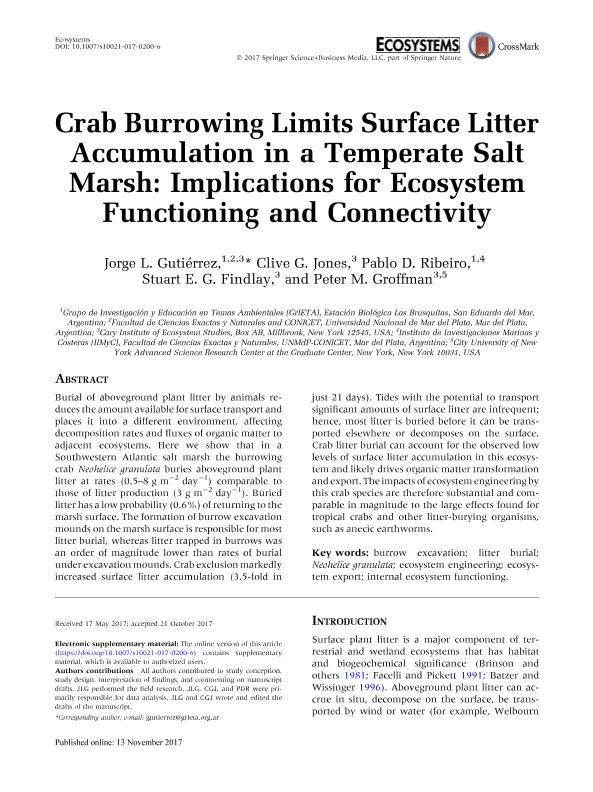Artículo
Crab Burrowing Limits Surface Litter Accumulation in a Temperate Salt Marsh: Implications for Ecosystem Functioning and Connectivity
Gutierrez, Jorge Luis Ceferino ; Jones, Clive G.; Ribeiro, Pablo Damián
; Jones, Clive G.; Ribeiro, Pablo Damián ; Findlay, Stuart E. G.; Groffman, Peter M.
; Findlay, Stuart E. G.; Groffman, Peter M.
 ; Jones, Clive G.; Ribeiro, Pablo Damián
; Jones, Clive G.; Ribeiro, Pablo Damián ; Findlay, Stuart E. G.; Groffman, Peter M.
; Findlay, Stuart E. G.; Groffman, Peter M.
Fecha de publicación:
08/2018
Editorial:
Springer
Revista:
Ecosystems
ISSN:
1432-9840
e-ISSN:
1435-0629
Idioma:
Inglés
Tipo de recurso:
Artículo publicado
Clasificación temática:
Resumen
Burial of aboveground plant litter by animals reduces the amount available for surface transport and places it into a different environment, affecting decomposition rates and fluxes of organic matter to adjacent ecosystems. Here we show that in a Southwestern Atlantic salt marsh the burrowing crab Neohelice granulata buries aboveground plant litter at rates (0.5–8 g m−2 day−1) comparable to those of litter production (3 g m−2 day−1). Buried litter has a low probability (0.6%) of returning to the marsh surface. The formation of burrow excavation mounds on the marsh surface is responsible for most litter burial, whereas litter trapped in burrows was an order of magnitude lower than rates of burial under excavation mounds. Crab exclusion markedly increased surface litter accumulation (3.5-fold in just 21 days). Tides with the potential to transport significant amounts of surface litter are infrequent; hence, most litter is buried before it can be transported elsewhere or decomposes on the surface. Crab litter burial can account for the observed low levels of surface litter accumulation in this ecosystem and likely drives organic matter transformation and export. The impacts of ecosystem engineering by this crab species are therefore substantial and comparable in magnitude to the large effects found for tropical crabs and other litter-burying organisms, such as anecic earthworms.
Archivos asociados
Licencia
Identificadores
Colecciones
Articulos(CCT - MAR DEL PLATA)
Articulos de CTRO.CIENTIFICO TECNOL.CONICET - MAR DEL PLATA
Articulos de CTRO.CIENTIFICO TECNOL.CONICET - MAR DEL PLATA
Articulos(IIMYC)
Articulos de INSTITUTO DE INVESTIGACIONES MARINAS Y COSTERAS
Articulos de INSTITUTO DE INVESTIGACIONES MARINAS Y COSTERAS
Citación
Gutierrez, Jorge Luis Ceferino; Jones, Clive G.; Ribeiro, Pablo Damián; Findlay, Stuart E. G.; Groffman, Peter M.; Crab Burrowing Limits Surface Litter Accumulation in a Temperate Salt Marsh: Implications for Ecosystem Functioning and Connectivity; Springer; Ecosystems; 21; 5; 8-2018; 1000-1012
Compartir
Altmétricas



